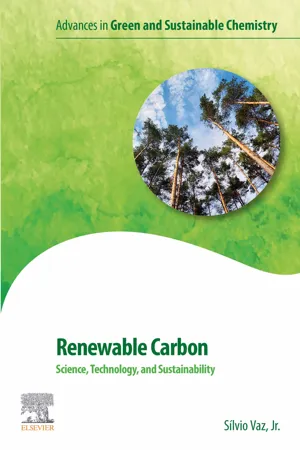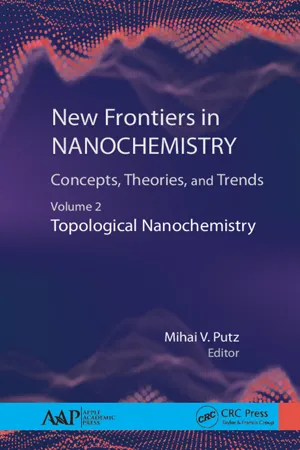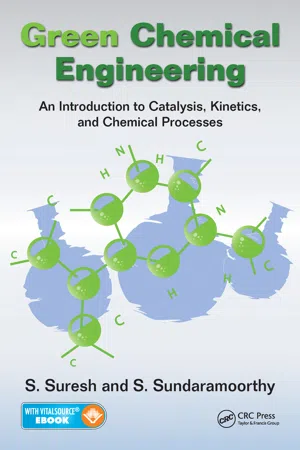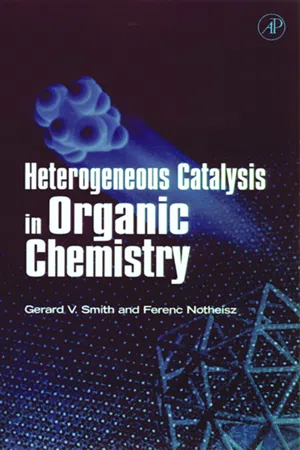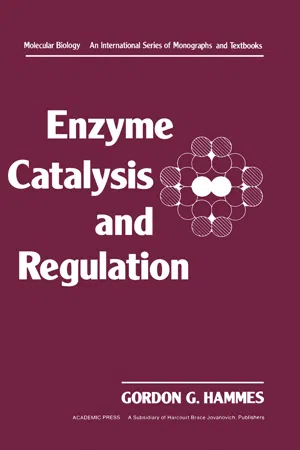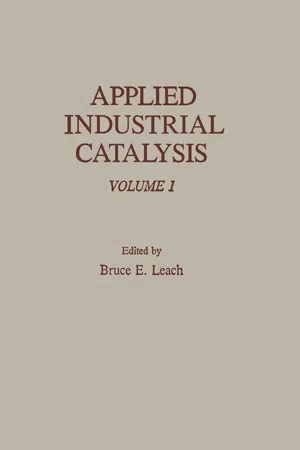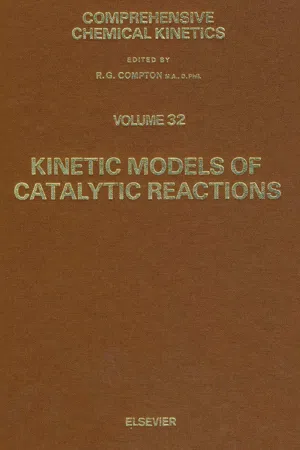Chemistry
Catalysis
Catalysis is the process of increasing the rate of a chemical reaction by the presence of a substance known as a catalyst. The catalyst itself remains unchanged at the end of the reaction and can be used repeatedly. This process is essential in many industrial and laboratory chemical reactions to improve efficiency and reduce energy consumption.
Written by Perlego with AI-assistance
Related key terms
1 of 5
12 Key excerpts on "Catalysis"
- eBook - ePub
Renewable Carbon
Science, Technology and Sustainability
- Silvio Vaz Jr.(Author)
- 2022(Publication Date)
- Elsevier(Publisher)
2 into chemicals is, mostly, unfavorable from both the thermodynamic and kinetic point of view, which leads to the need for catalysts to perform the related reactions. To differ it from bioCatalysis using enzymes, it is defined as chemoCatalysis.According the International Union of Pure and Applied Chemistry (2021a) , a catalyst is a substance that increases the rate of a reaction without modifying the overall standard Gibbs energy change in the reaction, a process called Catalysis. The catalyst is both a reactant and product of the reaction. The words catalyst and Catalysis should not be used when the added substance reduces the rate of reaction. Catalysis can be classified as homogeneous and heterogeneous; in the first, only one phase is involved, and in the second, the reaction occurs at or near an interface between phases.Catalysis brought about by one of the products of a reaction is called autoCatalysis. Catalysis brought about by a group of reactant molecules is called intramolecular Catalysis. The term Catalysis is also often used when the substance is consumed in the reaction, for example, base-catalyzed hydrolysis of esters. Strictly, such a substance should be called an activator (International Union of Pure and Applied Chemistry, 2021a).Catalysts allow the reaction to proceed along a path at a lower activation energy (Fig. 11.1 ), which leads to an increase in reaction rate and a decrease in reaction time.Fig. 11.1 Comparison between activation energies for a reaction with the presence of catalyst (Eat1 ) and without the presence of catalyst (Eat2 ). (Credit: author.) - eBook - PDF
- Dmitry Murzin(Author)
- 2013(Publication Date)
- De Gruyter(Publisher)
1 The basics 1.1 Catalytic concepts 1.1.1 Definitions Catalysis is a phenomenon related to the acceleration of rates of chemical reactions. The available data on the conversion of starch to sugars in the presence of acids, com-bustion of hydrogen over platinum, decomposition of hydrogen peroxide in alkaline and water solutions in the presence of metals, and were summarized by a Swedish scientist J. J. Berzelius in 1836 (1), who proposed the existence of a certain body, which “effecting the (chemical) changes does not take part in the reaction and remains unal-tered through the reaction”. Catalytic power or force, according to Berzelius, meant that “substances (catalysts) are able to awaken affinities which are asleep at this temperature by their mere presence and not by their own affinity”. This concept was immediately criticized by Liebig, as this theory was placing cataly-sis somewhat outside of other chemical disciplines (2). A catalyst was later defined by Ostwald as “a compound that increases the rate of a chemical reaction, but which is not consumed by the reaction” (3). This definition allows for the possibility that small amounts of the catalyst are lost in the reaction or that the catalytic activity slowly declines. From these definitions, a direct link between chemical kinetics and Catalysis is apparently clear as, accordingly, Catalysis it is a kinetic process. There are, however, many issues in Catalysis that are not directly related to kinetics, such as mecha-nisms of catalytic reactions, elementary reactions, surface reactivity, adsorption of reactants on solid surfaces, synthesis and structure of solid materials and catalytic engineering. An important issue in Catalysis is selectivity towards a particular reaction. For exam-ple, transformation of synthesis gas (a mixture of CO and hydrogen) can lead either to methanol (on copper) or high alkanes (on cobalt). For consecutive reactions it could be desirable to obtain an intermediate product. - eBook - ePub
New Frontiers in Nanochemistry: Concepts, Theories, and Trends
Volume 2: Topological Nanochemistry
- Mihai V. Putz, Mihai V. Putz, Mihai Putz(Authors)
- 2020(Publication Date)
- Apple Academic Press(Publisher)
CHAPTER 4Catalysis
ADRIANA URDĂ and IOAN-CEZAR MARCU
Laboratory of Chemical Technology & Catalysis, Department of Organic Chemistry, Biochemistry & Catalysis, Faculty of Chemistry, University of Bucharest, 4-12, Blv. Regina Elisabeta, 030018 Bucharest, Romania, Tel: +40213051464, Fax: +40213159249,E-mail: [email protected] ; [email protected]4.1 DEFINITION
Catalysis represents the acceleration of thermodynamically possible chemical reactions by activating the reactants in the presence of compounds called catalysts. The acceleration comes from the lowered activation energy, which occurs when the reactant molecule interacts with the catalyst. Although the catalyst interacts with the reactant(s), it is not consumed in the reaction; therefore, it needs to be present only in very small amounts for the reaction to take place. Catalysis is one of the processes that support life through enzymatic reactions and, as a key concept in chemistry, it is involved in the synthesis of a large number of compounds used in everyday life.4.2 HISTORICAL ORIGIN(S)
Catalysis was already used in antiquity, even without knowing it: the alcoholic fermentation and the conversion of ethanol to acetic acid are chemical reactions catalyzed by enzymes (Bornscheuer & Buchholz, 2005; Hagen, 2006). In medieval times, the use of the philosopher’s stone to transform base metals into “gold” was a catalytic concept (Lohse, 1945).In 1834, Mitscherlich introduced the term “contact” in his report discussing the conversion of alcohol into ether and water in the presence of dilute sulfuric acid (Davis, 2008). The concept of “Catalysis” was coined by the Swedish chemist Berzelius in 1835 (Lohse, 1945; Somorjai, 1994), and in 1894, Ostwald defined it as “the acceleration of a slow chemical process by the presence of a foreign material” (Ertl, 2009), while the first definition of “catalyst” was given by Armstrong in 1885 (Davis, 2008). Later, in 1901, he defined a catalyst as “a material that changes the rate of a chemical reaction without appearing in the final product” (Ertl, 2009). Sabatier proposed in 1923 the temporary formation of unstable chemical compounds between catalysts and reactants, believing them to be intermediate steps in the reaction (Védrine, 2014). Kinetic studies in adsorption/desorption phenomena, crucial in heterogeneous catalyzed processes, were initiated by Langmuir and developed by Hinshelwood (Davis, 2008). - John Happel(Author)
- 2012(Publication Date)
- Academic Press(Publisher)
Chapter 1 Introduction 1 . 1 Definitions and Objectives In modeling catalytic reactions, the central question concerns the role of the catalyst, which influences the reaction rate of a desired process, and, consequently, the practicality of conducting it. Since the time of Berzelius, who is credited with coining the name catalyst for a material apparently not participating in a reaction but yet able to cause it to occur, there has been a tendency to use the term Catalysis to discribe a wide variety of phenomena that are not well understood. Thus, the subject of Catalysis is still something of an art as well as a science, but more quantitative theoretical and experimental approaches have become increasingly available. The definition of Rideal (1968) serves to draw a useful distinction between steps involving intermediates as contrasted to those that only involve terminal species. Catalysis is described as the phenomenon in which one or more substances isothermally (and nonradioactively) augment the rate of a chemical reaction without appearing in the stoichiometric equation of the reaction. What is meant by a stoichiometric equation is a chemical equation that describes the molecules of reactants that are transformed into corres-ponding molecules of products following the law of conservation of mass. Such an equation does not provide a description of the mechanism for the reaction in which individual steps are involved, producing intermediates that remain at constant concentrations during the course of the reaction as the latter proceeds under steady-state conditions. It is the reactions involving these intermediates that are critical in understanding catalytic behavior. 1 2 1 Introduction In heterogeneous Catalysis the catalyst constitutes one or more phases, which are distinct from reactants and products.- eBook - ePub
Chemistry for Sustainable Technologies
A Foundation
- Neil Winterton(Author)
- 2021(Publication Date)
- Royal Society of Chemistry(Publisher)
2 Evidence for this should already be apparent from the various contributions of Catalysis to waste minimisation in chemicals processing mentioned earlier. The purpose of this chapter, having first introduced the concept, is to explore and exemplify the central importance of Catalysis to the efficiency of industrial chemicals production—past, present and future. Also of industrial importance is the related concept of catalyst inhibition, a phenomenon that results from the direct effect on a catalyst of suppressing its activity rather than by any change to the reaction activation energy. The key empirical measures of catalyst performance are considered in Section 10.2.A catalyst is a chemical component of a reacting system that changes the rate of reaction without itself being consumed in the reaction being catalysed. The catalytic species may not be the material initially added, but may be derived from it. In such circumstances, the material added will be known as the pre-catalyst. Much of catalyst research is centred on identifying the precise nature of the active catalytic species, even its physical form. Investigating working catalysts under industrially-relevant conditions (‘operando’ studies2 ) is a major experimental and technical challenge. Advances in experimental and analytical techniques have also facilitated the study of Catalysis by isolated metal atoms (‘single atom Catalysis’Types of catalyst and Catalysis are many and varied, including:3a ,b).- heterogeneous Catalysis (Section 10.1.1);
- homogeneous Catalysis (Section 10.1.2);
- enzyme and bio-Catalysis (Section 10.1.3);
- organoCatalysis (Section 10.1.4);
- asymmetric Catalysis (Section 10.1.5);
- environmental Catalysis (Section 10.8);
- biphasic and phase transfer Catalysis;
- combinatorial Catalysis (Section 10.1.6);
- electroCatalysis and photoCatalysis (discussed briefly in Sections 9.10.3 and 9.10.1).
Each has been an important independent area of study and application. Several have been met incidentally in earlier chapters. Most will be introduced or further illustrated during the course of this and the remaining chapters on the use of renewable feedstocks for chemicals manufacture and energy generation. Increasingly, studies focus on the overlap between hitherto-independent areas of Catalysis and on aspects of material science and nanoscience, seeking new insights that might arise from unifying them at the molecular level.4 Detailed consideration of ‘hybrid Catalysis ’ and ‘tandem Catalysis - eBook - PDF
Green Chemical Engineering
An Introduction to Catalysis, Kinetics, and Chemical Processes
- S. Suresh, S. Sundaramoorthy(Authors)
- 2014(Publication Date)
- CRC Press(Publisher)
Later, it was J. Liebig and W. Ostwald who noted that the catalyst increases the rate of a chemical reaction without getting consumed by the reaction. A catalyst is a substance that alters the rate of a reaction but remains unchanged after the reaction. Many chemical reactions that are not feasible under normal conditions can be carried out in the presence of a catalyst. It is dif fcult to exaggerate the importance of Catalysis since many life processes and industrial processes would not be possible with-out it. Several industrially important reactions that drive the large-scale production of chemical products such as sulphuric acid, agricultural fertilisers, plastics and fuels are catalytic reactions. Catalytic cracking, catalytic reforming, aromatisation, isomerisation and so on in petrochemical industries, hydrogenation of vegetable oil, enzymatic reac-tions in food processing, conversion of sulphur dioxide into sulphur trioxide, ammonia synthesis, etc., are some of the common examples of industrially important catalytic chemical processes. Catalysts change reaction rates by promoting different mechanisms for the reactions. It is to be noted that even though a catalyst is not consumed in the reaction, it does take part in the chemical reaction but is not observed in the overall reaction. Catalysts activate mol-ecules and reduce the activation energy necessary for reactions to occur. Catalysts do not change the state of equilibrium; they only act to increase the rates at which the equilibrium state is attained. Catalysts can affect yield and selectivity of a chemical reaction because of their ability to change the reaction mechanism. Catalysis is an active area of research. Figure A.1 shows the yearly progress in the num-ber of research publications appearing in the area of Catalysis. - eBook - PDF
Fine Chemicals Manufacture
Technology and Engineering
- A. Cybulski, M.M. Sharma, R.A. Sheldon, J.A. Moulijn(Authors)
- 2001(Publication Date)
- Elsevier Science(Publisher)
0 Catalysis in Fine Chemicals 3.1. INTRODUCTION Catalysis opens reaction pathways that are not accessible to uncatalysed reactions. It should be self-evident that thermodynamics predict whether a reaction can occur. So, Catalysis influences reaction rates (and as a consequence selectivities), but the thermodynamic equilibrium still is the boundary. Catalysis plays a key role in chemical conversions, although it is fair to state that it is not applied to the same degree in all sectors of the chemical industry. While in bulk chemicals production catalytic processes constitute over 80 % of the industrially applied processes, in fine chemicals and specialty chemicals production Catalysis plays a relatively modest role. In the pharmaceutical industry its role is even smaller. It is the opinion of the authors that Catalysis has a large potential in these areas and that its role will increase drastically in the coming years. However, Catalysis is a multidisciplinary subject that has a lot of aspects unfamiliar to synthetic chemists. Therefore, it was decided to treat Catalysis in a separate chapter. Catalysis can be treated from various points of view. One might structure the discussion by starting from the organic reactions, e.g. selective hydrogenation, dehydrogenation, selective oxidation, and so on. Subsequently, for every class of reactions the potential of Catalysis could be outlined. Section 2.8 is structured in roughly such a way. Here we have chosen to treat the subject in a more discipline-oriented way. First, the principle of Catalysis is explained. Subsequently, the key properties of catalysts are discussed: activity, selectivity, and stability. For a good understanding it is crucial to have a good idea of the structure (both chemical and physical) of a catalyst. - eBook - PDF
- Gerard V. Smith, Ferenc Notheisz(Authors)
- 1999(Publication Date)
- Academic Press(Publisher)
1 CHAPTER 1 Introduction to Catalysis 1.1. Definitions and Language of Catalysis 1.2. Special Considerations for Heterogeneous Catalysis in Liquids 1.3. Drawing and Naming Surface Species in Organic Reactions on Surfaces 1.4. Hydrogen Sources 1.5. Books on Heterogeneous Catalysis of Organic Reactions References 1.1. DEFINITIONS AND LANGUAGE OF Catalysis In any field, certain definitions and language must be understood, and the field of Catalysis is no exception. Thus we start with some definitions before describing organic reactions on surfaces. 1.1.1. W HAT I S A C ATALYTIC R EACTION ? A catalytic reaction is one in which more than one turnover or event occurs per reaction center or catalytically active site (that is, the turnover number [TON] is greater than 1). Thus a reaction is not catalytic if it is stoichiometric or if its TON is less than 1. A reaction might indeed involve a true catalyst and under some circumstances be catalytic, but if one or fewer turnovers occur per active site, it is not a catalytic reaction. 2 Chapter 1 Introduction to Catalysis 1.1.2. W HAT I S A C ATALYST ? A catalyst is a substance that increases the rate of a chemical reaction without itself being changed in the process. That is, the substance called a catalyst is the same after the reaction as before. During the reaction, it may become a dif-ferent entity, but after the catalytic cycle is complete, the catalyst is the same as at the start. A catalyst is not light or heat or any sort of electromagnetic radiation. These are not substances in the ordinary sense and therefore are not catalysts. What a catalyst does is change the reaction pathway to one with a lower energy; however, one must remember that the rate of a chemical reaction depends on two things: the rate constant, which contains energy terms (both enthalpy and entropy), and concentration terms. - eBook - PDF
- Gorden Hammes(Author)
- 2012(Publication Date)
- Academic Press(Publisher)
5 Some Chemical Aspects of Enzyme Catalysis Catalysis Every chemical reaction proceeds by the reactants going through a series of different states until the products are reached. In molecular terms the intermediate states have changes in bond lengths, angles, etc. Very often this gradual transition from reactants to products is simplified by assuming the reactants are in equilibrium with a single transition state, and that products are produced by the breakdown of the transition state. The overall rate of the reaction then can be expressed in terms of the equilibrium constant characterizing the equilibrium between the reactants and the transition state and the rate of breakdown of the transition state into products. In the very simplest theory, the rate constant, /c, for reactions in liquid solutions is expressed as k = ^Le'^ t/RT (5-1) N 0 h = HL e ur t lR e -ur*iRT ( 5 . 2 ) N 0 h where AG ot ( = ΔΗ οΐ — TàS oî ) is the standard free energy change for the conversion of reactants to transition state (usually called the free energy of activation), AH oi is the standard enthalpy change, AS 0 * is the standard entropy change, R is the gas constant, Γ is the absolute temperature, N 0 is Avogadro's number, and h is Planck's constant (cf. / for a detailed description of the transition state theory). 76 Acid-Base Catalysis 77 Catalysis can be regarded as a stabilization of the intermediate states, or in terms of transition state theory as a stabilization of the transition state with respect to the reactants. In other words, AG°* is decreased. (However, a state-ment such as this is only meaningful if the uncatalyzed and catalyzed reac-tions proceed through the same reaction pathway.) This is a formal way of stating that catalysts increase the rate of a chemical reaction but are not consumed during the reaction. Of course, a catalyst accelerates the forward and reverse reactions an equal amount since the equilibrium constant cannot be altered by a catalyst. - eBook - PDF
Advanced Oxidation Processes
Applications, Trends, and Prospects
- Ciro Bustillo-Lecompte(Author)
- 2020(Publication Date)
- IntechOpen(Publisher)
47 Chapter 3 Applications of Chemical Kinetics in Heterogeneous Catalysis Zhenhua Zhang, Li-Ping Fan and Yue-Juan Wang Abstract Chemical kinetics is a key subdiscipline of physical chemistry that studies the reaction rate in every elemental step and corresponding catalytic mechanism. It mainly concludes molecular reaction dynamics, catalytic dynamics, elemental reaction dynamics, macrodynamics, and microdynamics. Such a research field has wide applications in heterogeneous Catalysis. Based on the Arrhenius plot fitted by the catalytic conversions below 15% without the mass transfer effect and heat transfer effect, the apparent activation energy echoing with the intrinsically cata-lytic sites and the pre-exponential factor echoing with the relative number of active sites can be, respectively, derived from the slope and intercept of the Arrhenius plots, which can be used to compare the intrinsically catalytic activity of different catalysts and the relative amount of active sites. Reaction orders of both reactants and products are derived from the reaction rate equation and also fitted by the catalytic conversions below 15% without the mass transfer effect and heat transfer effect. According to the acquired reaction orders, the reaction mechanism can be proposed and even defined in some simple reactions. Therefore, investigations of chemical kinetics are of extreme importance and meaning in heterogeneous Catalysis. Keywords: Arrhenius equation, reaction rate equation, apparent activation energy, reaction order, heterogeneous Catalysis 1. Introduction Chemical kinetics, also known as reaction kinetics or chemical reaction kinetics, is a key branch of physical chemistry. Its main task is to investigate the rate during chemical process and to propose the catalytic mechanism of chemical process by a method of research object acting as a nonequilibrium dynamic system whose proper-ties change with time [1, 2]. - eBook - PDF
- Bruce Leach(Author)
- 2012(Publication Date)
- Academic Press(Publisher)
2 Bruce E. Leach It is th e interactio n of business , markets , economics , an d politic s with chemistr y tha t distinguishe s industr y fro m academia . Chemica l principle s an d th e laws of thermodynamic s still apply . Th e definitio n of a catalys t is th e same a materia l tha t change s th e rat e of a reactio n withou t itself bein g consumed . Catalyst s hav e no effect on th e positio n of equilibrium , an d one canno t mak e a reactio n procee d tha t is forbidde n by th e laws of thermody namics . A catalys t act s to lower th e activatio n energ y barrie r for reaction s tha t hav e a net decreas e in fre e energy . Th e alternat e reactio n path s provide d by catalyst s withi n th e laws of thermodynamic s an d chemistr y ad d valu e to feedstoc k material s in th e refinin g an d chemica l processin g industry . Th e fundamenta l aspect s of adsorptio n on activ e sites ar e adequatel y covere d in most catalysi s referenc e works . Th e catalysi s scientis t shoul d be knowledgeabl e abou t adsorptio n an d kineti c experiment s an d thei r results . For example , in th e reactio n A B (Fig. 1), a serie s of step s in th e catalyti c reactio n can be considered : (1) externa l diffusion , k cxt diff = k g s ext ; (2) inter na l diffusion , k int diff = k s S int ri; (3) adsorption , / c a d s ; (4) surfac e reaction , /c s ; (5) desorptio n of B; (6) interna l diffusio n of B; an d (7) externa l diffusio n of B. In externa l diffusio n th e size an d shap e of th e catalys t particle , th e volume/diamete r rati o of th e reactor , an d th e spac e velocity ar e factor s tha t influenc e th e amoun t of channeling , th e typ e of flow, th e exten t of back -mixing , an d th e residenc e time . Guideline s for catalys t evaluation s in laborator y reactor s ar e given in Chapte r 3. Interna l diffusio n is dependen t on th e por e structur e of th e catalyst . - eBook - PDF
- G.S. Yablonskii, V.I. Bykov, V.I. Elokhin, A.N. Gorban(Authors)
- 1991(Publication Date)
- Elsevier Science(Publisher)
Chapter 2 The Development of Basic Concepts of Chemical Kinetics in Heterogeneous Catalysis 1. Steps in the development of general chemical kinetics How far should one go in search of the sources of science? “The past is a well of ineffable depth” wrote Thomas Mann beginning his novel Joseph and his Brothers. As far as chemical kinetics is concerned, it is far from being true. Certainly, one can trace its remote sources (as far back as Empedocles and Aristotle), but the origin of this science is quite certain; it is the 1850s-1870s. The basic concepts of chemical kinetics as a science were for- mulated at that time on the basis of liquid-phase organic reactions. The pioneers of chemical kinetics Williamson, Wilhelmi, Sainte-Claire Deville, Berthelot, Pean de Sainte Jille and finally the authors of the law of mass action, Guldberg and Waage, had chosen etherification and the reverse reactions of saponification, the reaction of cane sugar transformation, etc. as the subjects of their investigations. As a rule, these reactions were catalytic. Catalysis as a specific chemical phenomenon, consisting of a drastic change of chemical reaction rates in the presence of some substan- ces, had been identified only slightly earlier. In 1836 Berzelius first used the concept of “Catalysis” in his paper Some thoughts concerning one agency acting in the formation of organic compounds in living nature but which so far have been unnoticed. Studies of the “enhancement” of chemical reactions should promote the interpretation of the concept of “reaction rate” and the conduct of special experiments. Probably, one may even say that catalytic investigations have catalyzed the development of chemical kinetics*. Williamson said: “There exist many evidences that chemical processes need time, but this commonly accepted fact is not taken into account in treating various phenomena”**. * Catalysis catalyzed the development of chemical kinetics but did not force its acceptance.
Index pages curate the most relevant extracts from our library of academic textbooks. They’ve been created using an in-house natural language model (NLM), each adding context and meaning to key research topics.
